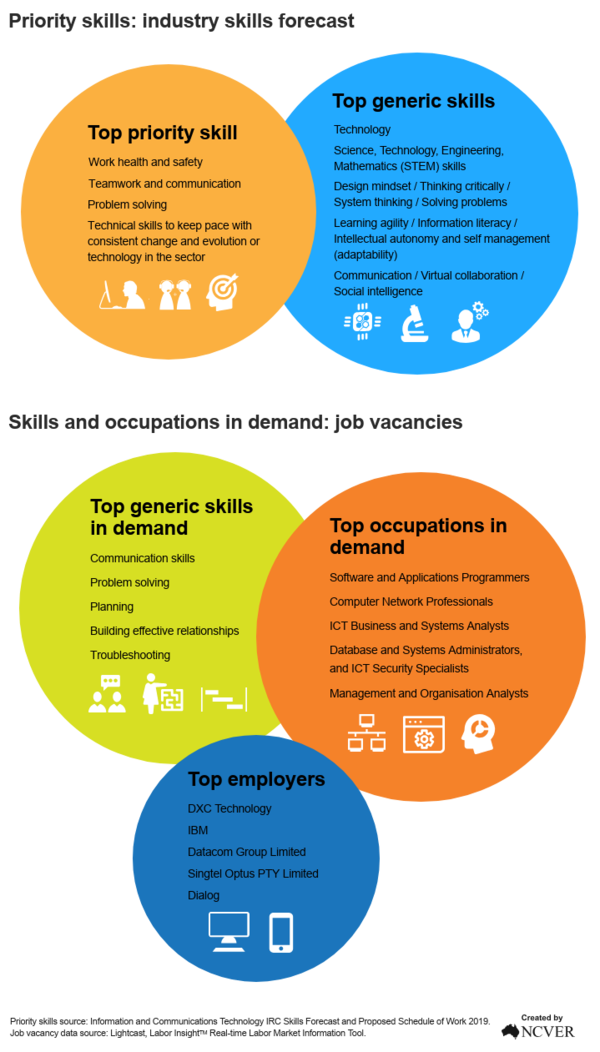
Industry insights on skills needs
According to the Information and Communications Technology IRC’s 2019 Skills Forecast, the priority skills for the Information and Communications Technology industry are:
According to job vacancy data, the top generic skills in demand in this industry are:
This job vacancy data showed the top occupations in demand as Software and Applications Programmers and Computer Network Professionals The top employers for the Information and Communication Technology industry include DXC Technology, IBM, and Datacom Group Limited.
In the Information and Communications Technology IRC’s 2019 Skills Forecast, the key demands impacting the ICT sector were:
-
Changing technology, including emerging technologies such as Artificial Intelligence (AI) and Internet of Things (IoT), and increasing growth in computing power and data volume requiring highly specialised skills to leverage, design and implement
-
Increasing adoption of automation technologies, estimated to impact 25–46% of current work activities by 2030 varying across sectors and job roles, increasing demand for ICT skills and job roles to lead and execute automation initiatives
-
The increasing importance of cyber security in the business landscape, due in part to new legislative requirements for the protection of personal data, driving demand for data security and privacy awareness skills
-
Increased competition, spurring a change in business models among ICT businesses, in turn changing the array of job roles and skills required to deliver services
-
The rollout of the National Broadband Network (NBN), both in removing the need to maintain legacy internet infrastructure from large telecom companies and in the changing skill needs for the rollout’s transition from implementation to ongoing maintenance and operation of the network itself.
The skills forecast identifies vendor certifications as being widely used and sought after in the ICT industry. A Vendor Certification Working group reporting to the ICT Industry Reference Committee has been established to consider how vendor certifications may be accommodated in the vocational education and training (VET) system. The skills forecast also identifies that higher level qualifications are in demand in the ICT sector, with many ICT VET graduates going on to undertake further training.
ACS Australia’s Digital Pulse 2021: Future directions for Australia's technology workforce forecasts there will be over 1.1 million technology workers in Australia by 2026, and is forecasted to require an Artificial Intelligence (AI) specialist workforce of between 32,000 and 161,000 by 2030. This includes professionals in computer vision, robotics, data science, human language technologies, and other related fields. Nearly half of this growth is forecast to occur in ICT technical and professional roles, while a further 26% of growth is expected to occur in ICT management and operations roles.
Advances in applied emerging technologies, including in advanced data science, artificial intelligence, augmented and virtual reality, and blockchain are presenting significant opportunities. Case for Change: ICT Information and Communications Technology Training Package finds employers are increasingly seeking employees with skills in applied emerging technologies to fulfil the requirements of in-demand jobs like artificial intelligence specialists, blockchain solution architects and robotics software engineers. Since the ICT industry is only going to continue advancing, it is critical that available training reflects current industry trends so that Australia’s workforce is equipped with in-demand ICT skills.
The Technology, Media, and Telecommunications Predictions 2021 report produced by Deloitte’s Technology, Media and Telecommunications (TMT) group highlights intelligent edge, cloud migration, 5G, and XR (a combination of virtual, augmented and mixed reality) in its predictions for the coming years. Expansion of the intelligent edge will be driven primarily by telecoms deploying the intelligent edge for 5G and future G networks, and by hyperscale cloud providers optimizing their infrastructure and service offerings.
The Hi-Tech Sector Plan 2030 identifies eight frontier technologies that will support economic growth in South Australia, and includes: Industry 4.0; Cyber Security; Quantum Computing; Internet of Things; Computer vision, Augmented Reality and Virtual Reality; Block Chain; Artificial intelligence, machine learning and advanced data analytics; and Optics and photonics. South Australian Industry Skills Councils identified skills across STEM and ICT, as well as specific hi-tech expertise in artificial intelligence, machine learning, robotics and data analytics as vital for growing all industries.
Digital Economy Strategy 2030 reports that government investments have been made to expand high-speed internet and mobile coverage in regional Australia, and in the underlying infrastructure to support next generation telecommunications technologies, such future G technologies.
Cyber security continues to be one of the most rapidly expanding sectors worldwide. While the pandemic is having economic impact on Australia’s cyber security providers, it has accelerated digitisation trends and driven unprecedented domestic demand for cyber security. According to Australia’s Cyber Security Competitiveness Plan 2020 Update, Australians are expected to spend $7.6 billion on cyber security from both local and international providers by 2024. Over the next decade, the Australian cyber security sector will become larger and an additional 7000 jobs are projected to be added to the industry, totalling 33,500 in Australia’s workforce. The report lists also skills shortages as one of the key future growth challenges.


